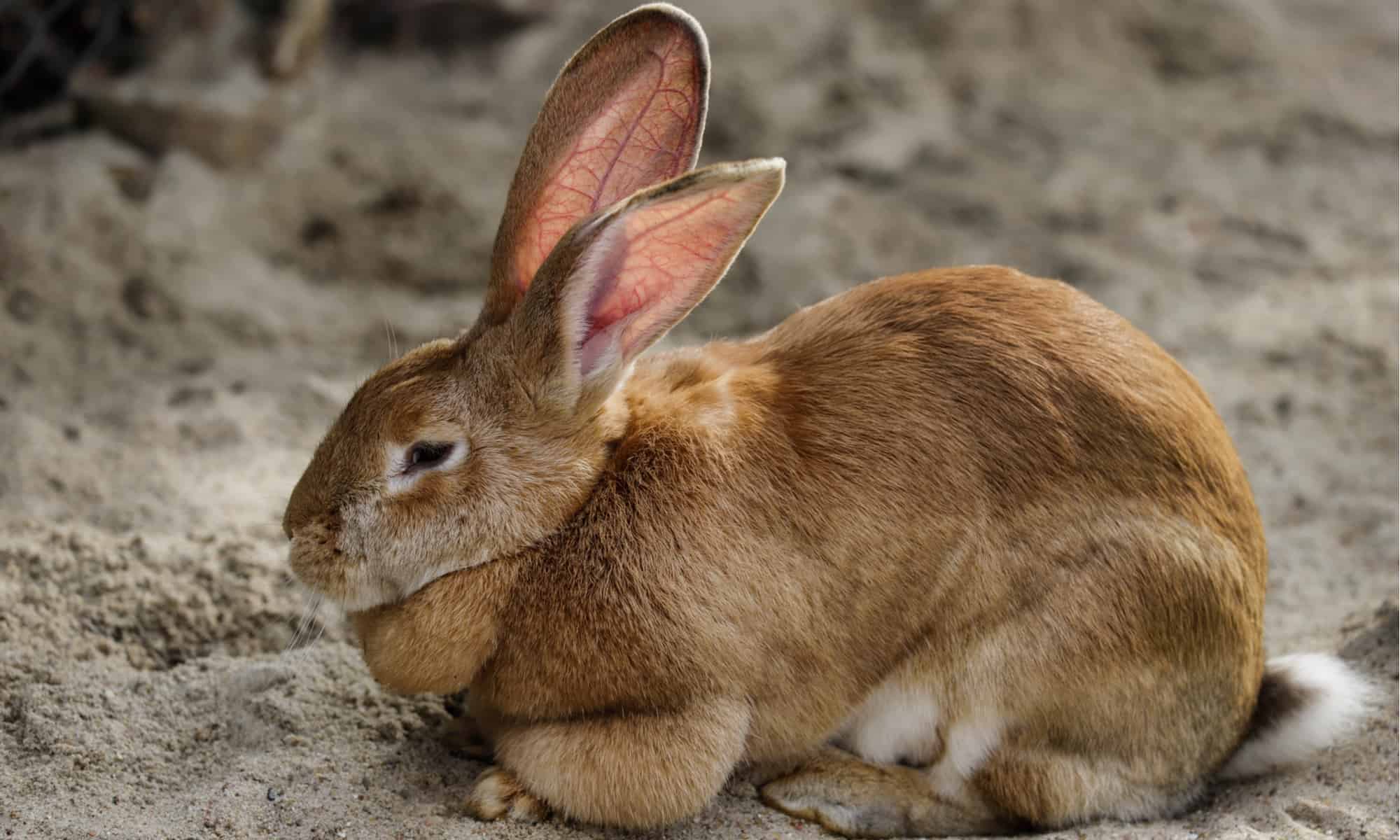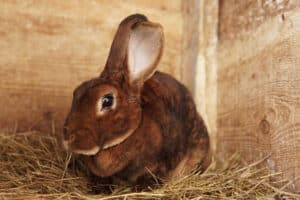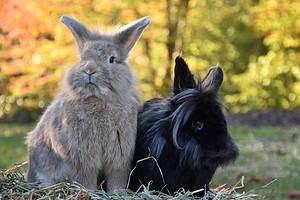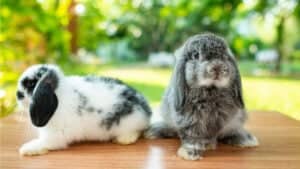The Oryctolagus cuniculus, or Flemish giant rabbit, can make a gentle and affectionate pet for your family. Larger than a small or average-sized dog, the Flemish giant rabbit ranges between 15 and 22 pounds heavy and 2.5 to 3.5 feet long. While they don’t have a particularly lengthy lifespan (the rabbits commonly live between four to nine years), Flemish giant rabbits are sociable, docile pets families can enjoy taking care of.
Flemish Giant Rabbits as Gentle and Affectionate Pets
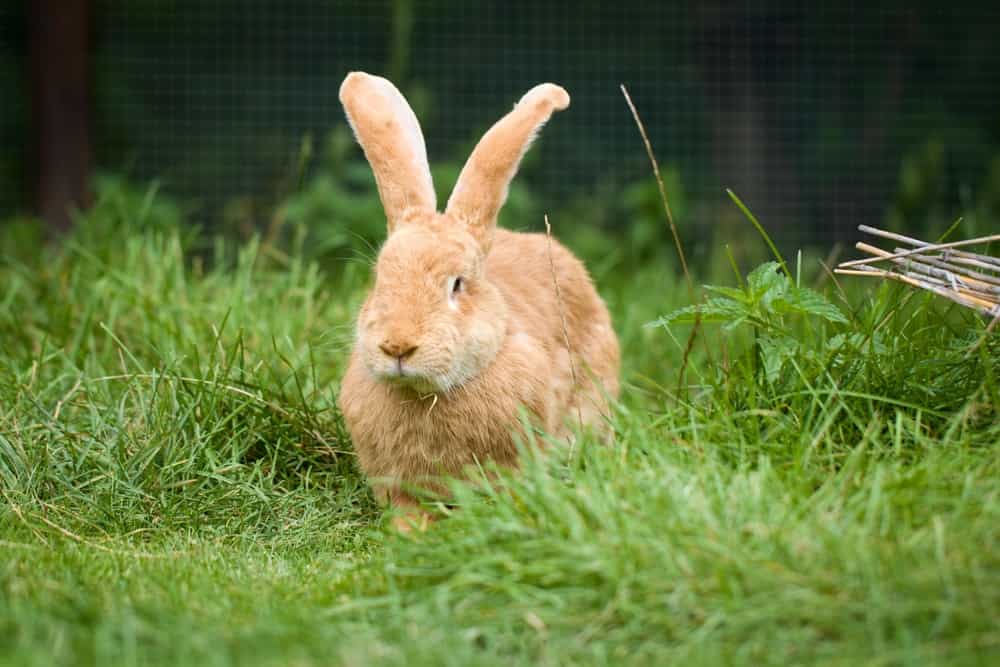
Flemish giant rabbits remain “gentle giants” perfect for families.
©Dan_Koleska/Shutterstock.com
As pets, the Flemish giant rabbit has similar needs to a standard rabbit… just more. It will need more space, more food, and perhaps more veterinary care. The “gentle giant” rabbit, recognized by the American Rabbit Breeder Associate (ARBA) as one of over fifty breeds of rabbits, has a unique temperament and an interesting diet.
Learn more about caring for and raising an affectionate Flemish giant rabbit.
Temperament and Personality: Exploring the Calm and Docile Nature of Flemish Giant Rabbits
Flemish giant rabbits make great pets thanks to their sociable personality, interest in human interaction, and intelligence. These rabbits choose their “favorite” human and give that person extra special attention, including bringing toys or playing with them, asking for calm pets, and standing on their hind legs to demand attention.
Surprisingly, Flemish giant rabbits have a high tolerance for interactions with humans and seek out a lot of attention — both of which characteristics make this breed of rabbit a great choice for families with toddler (or older) children. They enjoy hopping around the house or backyard, playing, cuddling, and feeling taken care of by their humans.
The personality of a Flemish giant rabbit will shift by individual animal and their backgrounds, but on average, these rabbits remain sweet-natured unless threatened. While families don’t intend to make their rabbits uncomfortable, it can accidentally happen if:
- Children squeeze the rabbit too tight or hold it too long.
- Other animals in the household threaten it.
- You pet the rabbit past the point it wants to be touched.
- A family member accidentally steps on a paw, tail, etc.
Because it’s still a rabbit — and as such, is a prey animal — Flemish giant rabbits can become threatened or frightened easily. When they do, they will act like a normal rabbit does to protect itself, including kicking, biting, thrashing, and scratching. To avoid raising an unsociable rabbit, handle it often when it’s a kitten.
Diet and Nutrition: Understanding the Proper Feeding Requirements for Optimal Health
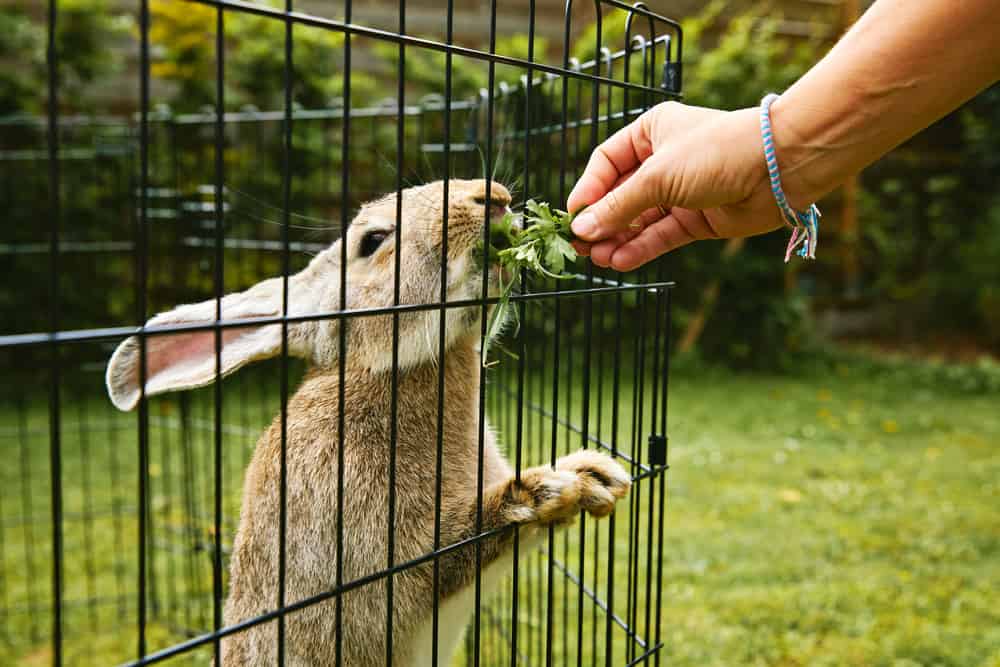
You can feed your Flemish giant rabbit vegetables from the garden.
©mariesacha/Shutterstock.com
For families who’ve owned rabbits before, taking care of a Flemish giant rabbit’s diet and nutrition needs is exceptionally easy: they require the exact same food as normal rabbits — just a lot more of it. Flemish giant rabbits can (and will!) eat up to five times the amount of a normal rabbit.
Ideally, families should look to feed their Flemish giant rabbit an unending supply of Timothy Hay and a constantly-full source of water. Consider serving several egg cups of high-fiber pellets too to keep your rabbit’s coast sleek and its belly full. Check in regularly with your veterinarian regarding your Flemish giant rabbit’s diet — if your rabbit is gaining too much weight or has had inconsistent/unusual bowel movements, it may be time to change the routine.
When it comes to treats, Flemish giant rabbits can snack on a plethora of great foods. Many vegetables, fruits, and plants make great snacks for your Flemish giant rabbit, including:
- Bananas.
- Cucumbers.
- Dandelions.
- Pineapple.
- Sweet potato.
- Zucchini.
Most foods that Flemish giant rabbits should avoid are obvious no-nos for animals (like chocolate, sugary foods, or white bread), but an interesting type of snack Flemish giant rabbit owners should refrain from giving are cabbage and Iceberg Lettuce.
Considerations For Feeding Flemish Giant Rabbits
Not all hay is created equal. Alfalfa Hay isn’t terrible for your rabbits, but it is known to create “bladder sludge” in rabbits two years and older from its high calcium and calorie contents. In addition, orchard grass has very little nutrients but looks similar to Timothy Grass. Overall, strive to give your rabbits Timothy Grass as it has most of the nutrients your rabbit needs and provides variety in its blades of grass.
Care and Maintenance: Providing a Suitable Environment, Grooming, and Exercise for Flemish Giant Rabbits

Flemish giant rabbits enjoy something soft to lay on to prevent sore hocks.
©nigel baker photography/Shutterstock.com
As with food, Flemish giant rabbits can live in an enclosure like other rabbits — it just has to be big enough to be comfortable. On average, that means an enclosure should be at least ten feet long and four feet wide for your rabbit to make at least three consecutive jumps across and lay comfortably across the enclosure’s width.
Furthermore, ensure the enclosure is tall enough. Your rabbit should be able to stand on its hind legs and still have some room before bumping their head, which often means about four feet high as well. Experts suggest an aviary or a sequestered, small room in your home without exposing wires or electricity to house your rabbit. Sheds may work well too.
Whether you choose to keep your rabbit inside or outside, ensure the temperature doesn’t get above 90 degrees and its environment has low humidity (meaning no laundry rooms). Due to their size, Flemish giant rabbits are prone to sore hocks, so wherever you make their home, ensure it has a layer of bedding made of blankets or hay.
Grooming Your Rabbit
Flemish giant rabbits’ have seven accepted breed colorings: black, blue, fawn, light gray, steel gray, sandy, and white. The striking colors of these rabbits’ luscious and glossy coats don’t shine without some effort. Owners should set at least half an hour aside a week to groom rabbits with meticulous brushing. Thankfully, Flemish giant rabbits tend to enjoy being brushed, which makes daily, weekly, and monthly maintenance of their coat a bonding experience more than anything. Consider getting three different brushes for your Flemish giant rabbit’s coat: a soft brush, a rubber brush, and a slicker brush.
Brushing often and de-shedding your rabbit is important because if rabbits ingest too much of their own fur, they become at risk for GI stasis. This medical condition can become fatal if not treated properly.
Finally, Flemish giant rabbits need exercise and mental stimulation to maintain their affable demeanor. Consider building or buying a series of large tunnels and cardboard boxes to create a maze. Make food interesting by varying the treats and add-ins for their meals, or try to hide snacks so they can fight boredom by searching out the fun-to-eat treat.
Health Considerations: Recognizing Common Health Issues and Regular Veterinary Care for Flemish Giant Rabbits

Flemish giant rabbits are large and may contract health issues related to their size.
©Rita_Kochmarjova/Shutterstock.com
Flemish giant rabbits have a few common health issues. Older Flemish giant rabbits may have issues like cardiomyopathy or spondylosis. Across the board, these rabbits are susceptible to sore paws, a condition caused by the pressure exerted on their feet. This issue typically arises when they are housed on wire mesh flooring. Other significant health issues include the following.
Rabbit Respiratory Infections
The bacterium P.Multocida is responsible for causing rabbit respiratory infections, commonly known as rabbit snuffles. Research from Sage Pub suggests that Flemish Giants are more prone to experiencing severe symptoms compared to New Zealand Giants, indicating a higher susceptibility among Flemish Giants.
Weight Issues
Large rabbits like the Flemish giant rabbit are at a higher risk of obesity compared to their smaller counterparts. This could be attributed to some owners underestimating the space required for giant rabbits to engage in proper exercise and overfeeding.
Make daily checks on your rabbit’s well-being by analyzing their ears, toenails, eyes, and teeth. As always, make regular vet appointments with your rabbit to monitor any health concerns you have for the rabbit.
Flemish Giant Rabbits: Great Pets For Families
Flemish Giant rabbits are exceptional pets with relatively low maintenance. Their gentle nature and docile temperament ensure they are suitable for families, their remarkable intelligence makes them easily trainable and interactive companions, and their relative healthiness contributes to their suitability as pets.
Thank you for reading! Have some feedback for us? Contact the AZ Animals editorial team.

